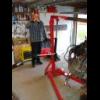Captain Mainwairing, that information is rather confusing, as it seems to be relating to the wrong grade of carbon steel. Also, work hardening is not good. There is no correlation at all between the data shown and the fatigue life, which is the most imporatnt thing in automotive applications.
The source of the data has a vested interest in selling stainless bolts, even where they are not appropriate. The following table in the link shows that a much lower design stress has to be used for stainless.
The subject is most complex, and every parameter has to be considered when choosing bolts that differ from the originals. In some cases it is not safe to replace an 8.8 bolt by a 12.9, even though it is stronger, because its fatigue life at the same cyclic stress level may be less, and it tends to be brittle. Actually, few steels have a fatigue limit significantly higher than "mild" steel, and ali, titanium and other exotic bolt materials don't have a fatigue limit at all, and can only safely be used where the peak to peak load range and total number of cycles is known.
Then there is the Chinese/Ebay problem. Almost all high tensile bolts originating from China are trash, indeed they are the very worst product category, followed by rolling element bearings, as far as bogus parts are concerned. We have continual monitoring of incoming materials at work, and it is amazing how many counterfeit items manage to find their way into what seem to be legitimate supply chains.
If in doubt, I would stick to the original bolts, every time.
It's not confusing at all if you're dealing with material specs frequently - people simply don't realize sometimes that even in 316 SS tube there are many different specs, mostly down to annealing and heat treatment.
You can buy 316SS as bright annealed (it's normally drawn from the mill in a high argon environment) that is used for medical and architectural applications, it's UTS doesn't come close to that of mild steel of a similar thickness.
A company I contracted to got caught out royally (and how they deserve it) - they built a machine structure in china, the frame was made from 50x50mm 304 box section. The minute I set eyes on it I knew something wasn't right - it was all bright and shiny. For years they used 2B brushed 50mm box for structures which by definition is 3/4 hard - with no trouble at all. The first time I heated this machine up (70 tonnes of stainless), the structure buckled and you couldn't open the doors. With the "correct" material there was sufficient torsional stiffness in the frame that the expansion would cause the structure to slide on it's footplates - with the crap they used, it all buckled and the doors twisted and leaked.
If that wasn't enough - the 316 steel sheeting in the "wet" end of the machine started rusting, shafts snapped, bearings collapsed and loads more little joys.
Serves the buggers right for dumping a perfectly good workforce in the UK and selling their souls for tonnes of chinese crap.
Back to the plot - the chinese used bright annealed tube straight from the drawing process without using any shielding gas - you couldn't have heat treated it afterwards if you had wanted to.
The UK company buyer believed the crap the chinese sold him - they told him that 50x50x1.2 square box section 304 tube wasn't available in china and they had to special draw it for him - which was why it was shiny.
The bloody stuff wasn't even fit to make hand rails out of.
Generally there is a damned good reason why the OEM specs a material for a fastening, occasionally it can be improved upon, but many times there are far reaching implications that the DIY guy working in his garage could have no hope of realising.
I use SS on non critical parts where the tightening torque is low - clutch cover on the bike and various frame fixings, but not for anything that might cause my face to contact the tarmac if it breaks.
![]()
















